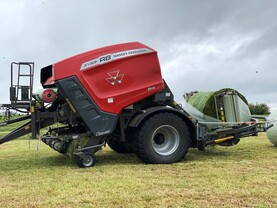Energy crop growers in NI are removing willow plantations due to a drop in demand for biomass fuel, reports from local farmers and contractors indicate.
Willow is grown as short-rotation coppice in NI and is usually harvested once every three years as woodchip for biomass fuel. According to DAERA’s agricultural census, there were 700ha of willow on NI farms last year.
However, Johnny Boggs from Gorthill Farm Contracting said that a growing number of farmers are enquiring about getting willow plantations removed to put ground back into conventional farmland.
The Eglinton-based contractors use a mulcher to break up the willow and its shallow root system in one pass.
“It’s on a three-point linkage for the back of the tractor. We use it for other things too, like breaking in ground or mulching whins,” Boggs said.
Cuts to Renewable Heat Incentive (RHI) tariffs are the main factor behind reduced demand for biomass fuel in NI. Former Ulster Farmers’ Union president Barclay Bell is planning to remove eight acres of willow on his arable and sheep farm near Rathfriland.
The land was originally planted to produce biomass fuel for Fane Valley’s former dairy processing plant at Banbridge. More recently, the willow has been used by Bell to fuel a grain dryer for his arable enterprise.
“We were using woodchip to dry grain instead of gas, but with RHI payments gone to where they are at, it doesn’t stack up any more,” the Co Down farmer said.
Bell said that the decision to remove the willow plantation was taken after the last crop was harvested in the spring.
“It’s safe to say that a lot more farmers with willow are thinking that way,” he said.
Read more
Willow, nutrients and biomass heating in Co Down
Watch: increasing output on Antrim sheep farm
Moy Park to cut NI production
RHI payments facing severe cuts
Energy crop growers in NI are removing willow plantations due to a drop in demand for biomass fuel, reports from local farmers and contractors indicate.
Willow is grown as short-rotation coppice in NI and is usually harvested once every three years as woodchip for biomass fuel. According to DAERA’s agricultural census, there were 700ha of willow on NI farms last year.
However, Johnny Boggs from Gorthill Farm Contracting said that a growing number of farmers are enquiring about getting willow plantations removed to put ground back into conventional farmland.
The Eglinton-based contractors use a mulcher to break up the willow and its shallow root system in one pass.
“It’s on a three-point linkage for the back of the tractor. We use it for other things too, like breaking in ground or mulching whins,” Boggs said.
Cuts to Renewable Heat Incentive (RHI) tariffs are the main factor behind reduced demand for biomass fuel in NI. Former Ulster Farmers’ Union president Barclay Bell is planning to remove eight acres of willow on his arable and sheep farm near Rathfriland.
The land was originally planted to produce biomass fuel for Fane Valley’s former dairy processing plant at Banbridge. More recently, the willow has been used by Bell to fuel a grain dryer for his arable enterprise.
“We were using woodchip to dry grain instead of gas, but with RHI payments gone to where they are at, it doesn’t stack up any more,” the Co Down farmer said.
Bell said that the decision to remove the willow plantation was taken after the last crop was harvested in the spring.
“It’s safe to say that a lot more farmers with willow are thinking that way,” he said.
Read more
Willow, nutrients and biomass heating in Co Down
Watch: increasing output on Antrim sheep farm
Moy Park to cut NI production
RHI payments facing severe cuts






 This is a subscriber-only article
This is a subscriber-only article









SHARING OPTIONS: